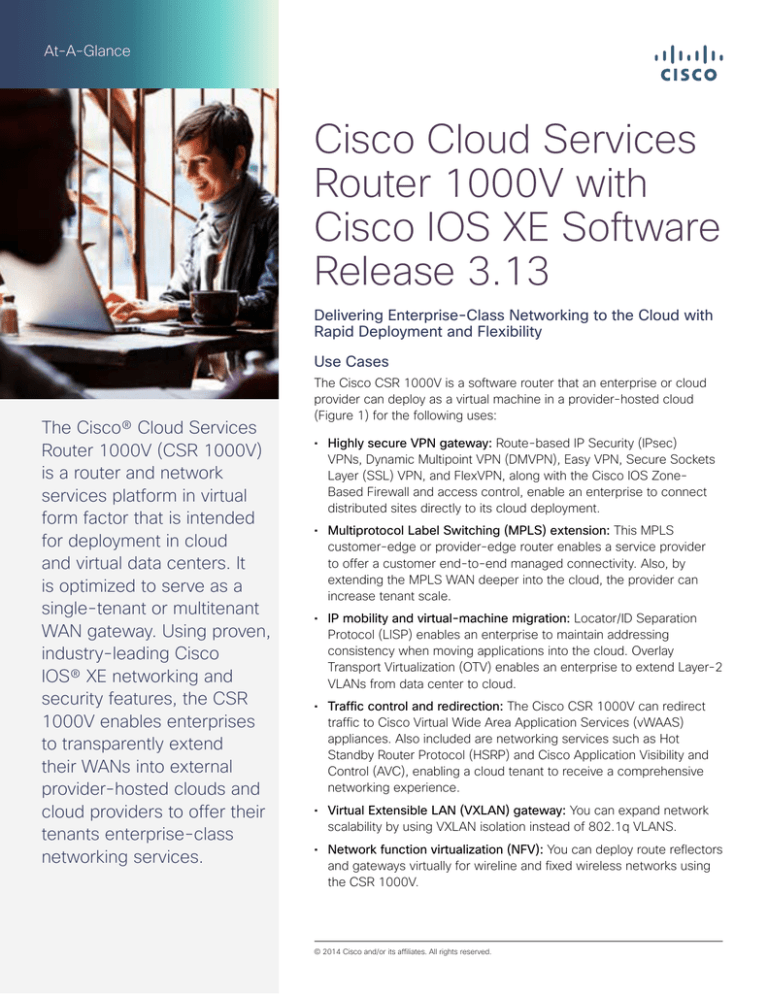
At-A-Glance
Cisco Cloud Services
Router 1000V with
Cisco IOS XE Software
Release 3.13
Delivering Enterprise-Class Networking to the Cloud with
Rapid Deployment and Flexibility
Use Cases
The Cisco® Cloud Services
Router 1000V (CSR 1000V)
is a router and network
services platform in virtual
form factor that is intended
for deployment in cloud
and virtual data centers. It
is optimized to serve as a
single-tenant or multitenant
WAN gateway. Using proven,
industry-leading Cisco
IOS® XE networking and
security features, the CSR
1000V enables enterprises
to transparently extend
their WANs into external
provider-hosted clouds and
cloud providers to offer their
tenants enterprise-class
networking services.
The Cisco CSR 1000V is a software router that an enterprise or cloud
provider can deploy as a virtual machine in a provider-hosted cloud
(Figure 1) for the following uses:
• Highly secure VPN gateway: Route-based IP Security (IPsec)
VPNs, Dynamic Multipoint VPN (DMVPN), Easy VPN, Secure Sockets
Layer (SSL) VPN, and FlexVPN, along with the Cisco IOS ZoneBased Firewall and access control, enable an enterprise to connect
distributed sites directly to its cloud deployment.
• Multiprotocol Label Switching (MPLS) extension: This MPLS
customer-edge or provider-edge router enables a service provider
to offer a customer end-to-end managed connectivity. Also, by
extending the MPLS WAN deeper into the cloud, the provider can
increase tenant scale.
• IP mobility and virtual-machine migration: Locator/ID Separation
Protocol (LISP) enables an enterprise to maintain addressing
consistency when moving applications into the cloud. Overlay
Transport Virtualization (OTV) enables an enterprise to extend Layer-2
VLANs from data center to cloud.
• Traffic control and redirection: The Cisco CSR 1000V can redirect
traffic to Cisco Virtual Wide Area Application Services (vWAAS)
appliances. Also included are networking services such as Hot
Standby Router Protocol (HSRP) and Cisco Application Visibility and
Control (AVC), enabling a cloud tenant to receive a comprehensive
networking experience.
• Virtual Extensible LAN (VXLAN) gateway: You can expand network
scalability by using VXLAN isolation instead of 802.1q VLANS.
• Network function virtualization (NFV): You can deploy route reflectors
and gateways virtually for wireline and fixed wireless networks using
the CSR 1000V.
© 2014 Cisco and/or its affiliates. All rights reserved.
nce
At-A-Glance
Benefits
• Rapid deployment and service
automation: Virtual form factor
accelerates deployment and
eliminates hardware costs
such as complete equipment
upgrades and Return Material
Authorizations (RMAs).
• Single-tenant use: This feature
allows a cloud service provider
to provision a routing instance
per tenant, simplifying service
delivery and tenant management.
It also helps the provider
overcome VLAN scale limits,
increasing tenant scale.
• Enterprise network extension to
the cloud: This feature provides
enterprises highly secure
direct connections from their
distributed sites to their cloudhosted applications, improving
application response time and
user experience.
• Network consistency: This
feature uses familiar enterpriseclass Cisco IOS Software
features for consistent network
operation across premises and
cloud, allowing the enterprise to
view the cloud as just another
node in its network.
• Network scalability: Scale
beyond the limitations of 802.1q
VLAN tagging by building a
VXLAN network, or extending
Layer-3 routing deeper into the
cloud environment.
• Consolidation of network
functions: Eliminate the facility
requirements and complexity
of physical network devices
by consolidating multiple route
reflectors and network gateways
onto a single piece of server
hardware.
Figure 1. Cisco CSR 1000V Positioned as a WAN Gateway in a Multitenant Cloud
Enterprise A
Data Center
CSR
1000V
Cisco ASR
App
App
OS
OS
App
OS
Branch
Tenant A
MPLS
WAN
Router
Cisco ISR
Enterprise B
Switches
CSR
1000V
Internet
Branch
Cisco ISR
App
Servers
App
OS
OS
App
App
OS
OS
Tenant B
Physical
Infrastructure
Virtual
Infrastructure
Features
• Routing: Border Gateway Protocol (BGP), Open Shortest Path
First (OSPF), Enhanced Interior Gateway Routing Protocol (EIGRP),
Policy-Based Routing, IPv6, Virtual Route Forwarding Lite (VRF-Lite),
Multicast, LISP, and Generic Routing Encapsulation (GRE)
• Addressing: Dynamic Host Configuration Protocol (DHCP), Domain
Name System (DNS), Network Address Translation (NAT), 802.1Q
VLAN, Ethernet Virtual Connection (EVC), and VXLAN
• VPN: IPsec VPN, DMVPN, Easy VPN, SSL VPN, and FlexVPN
• MPLS: MPLS VPN, VRF, and Bidirectional Forwarding Detection (BFD)
• Security: Cisco IOS Zone-Based Firewall; Access Control List (ACL);
Authentication, Authorization, and Accounting (AAA); RADIUS; and
TACACS+
• High availability: HSRP, Virtual Router Redundancy Protocol (VRRP),
and Gateway Load Balancing Protocol (GLBP)
• Traffic redirection: AppNav (to Cisco WAAS) and Web Cache
Communication Protocol (WCCP) application visibility, performance
monitoring, and control: Quality of service (QoS), AVC, and IP SLA
• Hybrid cloud connectivity: OTV, Virtual Private LAN Service (VPLS),
and Ethernet over MPLS (EoMPLS)
• Management: Command-line interface (CLI), Secure Shell (SSH)
Protocol, NetFlow, Simple Network Management Protocol (SNMP),
Embedded Event Manager, and RESTful application programming
interfaces (APIs)
• NFV: Virtual route reflector (vRR), Virtual broadband network gateway
(vBNG), and virtual intelligent services gateway (vISG)
The CSR 1000V can run on Cisco Unified Computing System™
(Cisco UCS®) servers or servers from leading vendors that support
VMware ESXi, Citrix XenServer, Microsoft Hyper-V, or Red Hat KVM or
on the Amazon Web Services cloud.
© 2014 Cisco and/or its affiliates. All rights reserved. Cisco and the Cisco logo are trademarks or registered trademarks of
Cisco and/or its affiliates in the U.S. and other countries. To view a list of Cisco trademarks, go to this URL: www.cisco.com/
go/trademarks. Third-party trademarks mentioned are the property of their respective owners. The use of the word partner
does not imply a partnership relationship between Cisco and any other company. (1110R)
C45-733405-00 12/14


